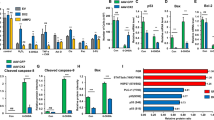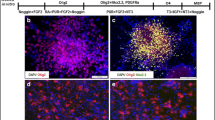Summary
Object
Patients with astrocytic tumors in the central nervous system (CNS) have low survival rates despite surgery and radiotherapy. Innovative therapies and strategies must be developed to prolong survival of these patients. The alginate microencapsulation method, used to continuously release a certain cytotoxic agent in the vicinity of the tumor, is such a novel therapeutic strategy. The biological functionality of the apoptosis inducing scFv425:sTRAIL protein, which was released through the microencapsulation method, was studied in vitro. Analysis of the intracerebral biocompatibility of alginate capsules was performed by implantation of empty alginate capsules in the brain of mice.
Method
Chinese Hamster Ovary cells (CHO-K1) were recombinantly engineered to produce the single chain anti-EGFR-sTRAIL protein (scFv425:sTRAIL). The CHO-K1 producer cells were encapsulated in an alginate capsule with a semi-permeable membrane through which the scFv425:sTRAIL protein could be released.
Results
In vitro studies show maintained biological functionality of the released scFv425:sTRAIL protein. There was no immunological tissue response detectable after intracerebral implantation of the alginate capsules in mice brains.
Conclusion
Biological functionality of the produced scFv425:sTRAIL protein is maintained and intracerebral biocompatibility of the capsules is warranted. Alginate encapsulation of CHO-K1 - scFv425:sTRAIL - producer cells and subsequently their intracerebral implantation is technically feasible. This study justifies further in vivo experiments.
Similar content being viewed by others
References
Ashkenazi A, Pai RC, Fong S, Leung S, Lawrence DA, Marsters SA, Blackie C, Chang L, McMurtrey AE, Hebert A, DeForge L, Koumenis IL, Lewis D, Harris L, Bussiere J, Koeppen H, Shahrokh Z, Schwall RH, Safety and antitumor activity of recombinant soluble Apo2 ligandJ Clin Invest 104: 155–162, 1999
Chinnaiyan AM, Prasad U, Shankar S, Hamstra DA, Shanaiah M, Chenevert TL, Ross BD, Rehemtulla A, Combined effect of tumor necrosis factor-related apoptosis-inducing ligand and ionizing radiation in breast cancer therapyProc Natl Acad Sci USA 97: 1754–1759, 2000
Arizono Y, Yoshikawa H, Naganuma H, Hamada Y, Nakajima Y, Tasaka K, A mechanism of resistance to TRAIL/Apo2L-induced apoptosis of newly established glioma cell line and sensitisation to TRAIL by genotoxic agentsBr J Cancer 88: 298–306, 2003
Zhang XD, Nguyen T, Thomas WD, Sanders JE, Hersey P, Mechanisms of resistance of normal cells to TRAIL induced apoptosis vary between different cell types FEBS Lett 482: 193–199, 2000
Roth W, Isenmann S, Naumann U, Kugler S, Bahr M, Dichgans J, Ashkenazi A, Weller M, Locoregional Apo2L/TRAIL eradicates intracranial human malignant glioma xenografts in athymic mice in the absence of neurotoxicityBiochem Biophys Res Commun 265: 479–483, 1999
Walczak H, Miller RE, Ariail K, Gliniak B, Griffith TS, Kubin M, Chin W, Jones J, Woodward A, Le T, Smith C, Smolak P, Goodwin RG, Rauch CT, Schuh JC, Lynch DH, Tumoricidal activity of tumor necrosis factor-related apoptosis- inducing ligand in vivoNat Med 5: 157–163, 1999
French LE, Tschopp J, The TRAIL to selective tumor deathNat Med 5: 146–147, 1999
Kim K, Fisher MJ, Xu SQ, El Deiry WS, Molecular determinants of response to TRAIL in killing of normal and cancer cellsClin Cancer Res 6: 335–346, 2000
Wajant H, Moosmayer D, Wuest T, Bartke T, Gerlach E, Schonherr U, Peters N, Scheurich P, Pfizenmaier K, Differential activation of TRAIL-R1 and −2 by soluble and membrane TRAIL allows selective surface antigen-directed activation of TRAIL-R2 by a soluble TRAIL derivativeOncogene 20: 4101–4106, 2001
Knight MJ, Riffkin CD, Muscat AM, Ashley DM, Hawkins CJ: Analysis of FasL and TRAIL induced apoptosis pathways in glioma cells Oncogene 13: 5789–5798, 2001
Bremer E, Kuijlen J, Samplonius D, Walczak H, de Leij L, Helfrich W, Target cell-restricted and -enhanced apoptosis induction by a scFv:sTRAIL fusion protein with specificity for the pancarcinoma-associated antigen EGP2Int J Cancer 109: 281–290, 2004
Emerich DF, Winn SR, Hantraye PM, Peschanski M, Chen EY, Chu Y, McDermott P, Baetge EE, Kordower JH, Protective effect of encapsulated cells producing neurotrophic factor CNTF in a monkey model of Huntington’s diseaseNature 386: 395–399, 1997
Mitsumoto H, Ikeda K, Klinkosz B, Cedarbaum JM, Wong V, Lindsay RM, Arrest of motor neuron disease in wobbler mice cotreated with CNTF and BDNFScience 265: 1107–1110, 1994
Winn SR, Wahlberg L, Tresco PA, Aebischer P, An encapsulated dopamine-releasing polymer alleviates experimental parkinsonism in ratsExp Neurol 105: 244–250, 1989
Read TA, Farhadi M, Bjerkvig R, Olsen BR, Rokstad AM, Huszthy PC, Vajkoczy P, Intravital microscopy reveals novel antivascular and antitumor effects of endostatin delivered locally by alginate-encapsulated cellsCancer Res 61: 6830–6837, 2001
Thorsen F, Read TA, Lund-Johansen M, Tysnes BB, Bjerkvig R, Alginate-encapsulated producer cells: a potential new approach for the treatment of malignant brain tumorsCell Transplant 9: 773–783, 2000
Joki T, Machluf M, Atala A, Zhu J, Seyfried NT, Dunn IF, Abe T, Carroll RS, Black PM, Continuous release of endostatin from microencapsulated engineered cells for tumor therapyNat Biotechnol19: 35–39, 2001
de Vos P, Hamel AF, Tatarkiewicz K, Considerations for successful transplantation of encapsulated pancreatic isletsDiabetologia 45: 159–173, 2002
Uludag H, de Vos P, Tresco PA, Technology of mammalian cell encapsulation Adv Drug Deliv Rev 42: 29–64, 2000
de Vos P, van Hoogmoed CG, de Haan BJ, Busscher HJ, Tissue responses against immunoisolating alginate-PLL capsules in the immediate posttransplant periodJ Biomed Mater Res 62: 430–437, 2002
Wolters GH, Fritschy WM, Gerrits D, van Schilfgaarde R, A versatile alginate droplet generator applicable for microencapsulation of pancreatic isletsJ Appl Biomater 3: 281–286, 1991
Fritschy WM, Gerrits PO, Wolters GH, Pasma A, van Schilfgaarde R, Glycol methacrylate embedding of alginate-polylysine microencapsulated pancreatic isletsBiotech Histochem 70: 188–193, 1995
Rokstad AM, Holtan S, Strand B, Steinkjer B, Ryan L, Kulseng B, Skjak-Braek G, Espevik T, Microencapsulation of cells producing therapeutic proteins: optimizing cell growth and secretionCell Transplant 11: 313–324, 2002
Acknowledgements
We acknowledged F Zuiderveen, R Horn and L van Genne for their technical assistance.
Author information
Authors and Affiliations
Corresponding author
Rights and permissions
About this article
Cite this article
Kuijlen, J.M., de Haan, B.J., Helfrich, W. et al. The efficacy of alginate encapsulated CHO-K1 single chain-TRAIL producer cells in the treatment of brain tumors. J Neurooncol 78, 31–39 (2006). https://doi.org/10.1007/s11060-005-9071-3
Received:
Accepted:
Published:
Issue Date:
DOI: https://doi.org/10.1007/s11060-005-9071-3




